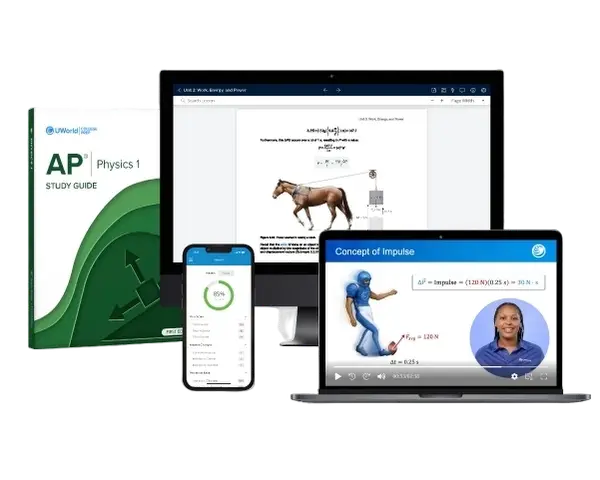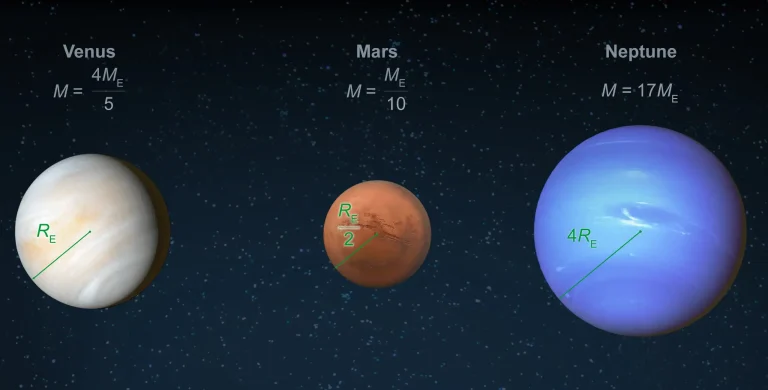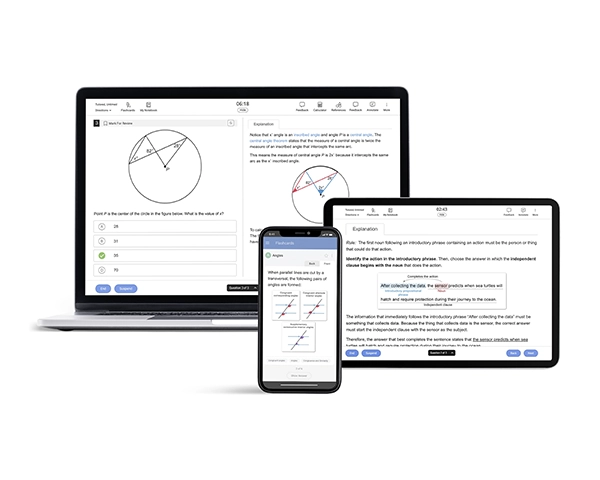One key reason students excel on the AP® Physics 1 is their familiarity with the exam structure. Like any AP exam, its format aligns with the course material. Knowing the number of sections, questions, time limits, and unit weightings helps you prepare more effectively. Understanding the exam structure ensures you won't be caught off guard, allowing you to approach each question with confidence.
What Is the Format of the AP Physics 1 Exam?
The AP Physics 1 exam is an introductory college-level physics course that utilizes algebra as its primary mathematical framework. Through classroom study, in-class activities, and hands-on laboratory work, you develop your understanding of physics. They delve into concepts such as systems, fields, force interactions, change, and conservation throughout the course.
The AP Physics 1 exam includes 2 main sections and lasts for a total of 3 hours. The sections include:
- Multiple-Choice Questions (MCQs): The MCQ section includes 40 multiple-choice questions. Multiselect questions have been removed from the exam structure. It accounts for 50% of the total exam score. You will have 1 hour and 20 minutes to complete it.
- Free-Response Questions (FRQs): Here, you will encounter 4 free-response questions of varying formats. You will have 1 hour and 40 minutes to complete this section. The FRQ section contributes 50% of the total exam score.
You will receive a sheet containing a table of constants and equations needed to answer questions in both sections of the exam. In addition, you will be allowed to use either a 4-function, scientific, or graphing calculator in both sections of the exam.
| Sections | Number of Questions | Score Weight | Total Time |
|---|---|---|---|
| Section 1: Multiple-Choice Questions (MCQs) | 40 | 50% | 1 hour 20 minutes |
| Section 2: Free-Response Questions (FRQs) | 4 | 50% | 1 hour 40 minutes |
Section 1: Multiple-Choice Questions
The multiple-choice section is first on the AP Physics 1 exam. These questions have 4 answer choices. MCQs will have only 1 right answer choice from the given set of options. Questions of this type can be either discrete, meaning an individual question, or sets of 2 or 3 questions. A set of questions provides a particular scenario with accompanying data, such as tables or graphs, if applicable, and asks 2 or 3 related discrete questions based on that information.
This exam section tests your skills in the science practices taught during the course. Here's the weighting of each science practice in section 1 of the AP Physics 1 exam.
Science Practices & Skills Evaluated
- Create diagrams, tables, charts, or schematics to represent physical situations.
- Create quantitative graphs with appropriate scales and units, including plotting data.
- Create qualitative sketches of graphs that represent features of a model or the behavior of a physical system.
- Derive a symbolic expression from known quantities by selecting and following a logical mathematical pathway.
- Calculate or estimate an unknown quantity with units from known quantities by selecting and following a logical computational pathway.
- Compare physical quantities between two or more scenarios or at different times and locations in a single scenario.
- Predict new values or factors of change of physical quantities using functional dependence between variables.
- Create experimental procedures that are appropriate for a given scientific question.
- Apply an appropriate law, definition, theoretical relationship, or model to make a claim.
- Justify or support a claim using evidence from experimental data, physical representations, or physical principles or laws.
In addition to testing your skills in science practices, you will also be tested on your knowledge of the topics and concepts covered in the 8 units of the course.
| Unit | Exam Weight |
|---|---|
| 1. Kinetics | 10-15% |
| 2. Force and Translational Dynamics | 18-23% |
| 3. Work, Energy, and Power | 18-23% |
| 4. Linear Momentum | 10-15% |
| 5. Torque and Rotational Dynamics | 10-15% |
| 6. Energy and Momentum of Rotating Systems | 5-8% |
| 7. Oscillations | 5-8% |
| 8. Fluids | 10-15% |
Remember to keep these weightings in mind as you study and review for the exam. With this information, you can plan out which units and science practices you need to focus on the most. You can also chart out how much time you will need for each unit based on their importance.
Given that you will have 40 questions to answer in 1 hour and 20 minutes, the maximum time you can spend per question would be about 2 minutes. Pacing yourself at one-and-half minutes per question ensures:
- You will have enough time to dedicate to questions in sets since you may need to keep referring back to the given information for clues.
- You will allow yourself enough time at the end of the section to go back and re-check your answers, or re-attempt any questions you might have skipped.
Remember, there are no penalties for incorrect answers in section 1 of the AP Physics 1 exam. So, be sure to attempt every question or at least take a guess.
Check out our article on how to approach multiple-choice questions in AP Physics 1 to see what a question in this section might look like and pick up some important tips and tricks.

Section 2: Free-Response Questions
The second section of the AP Physics 1 exam is the free-response section. You will find 4 free-response questions in this section that you will have to answer in 1 hour and 40 minutes. The answers in this section must be handwritten. Unlike the MCQ section, you will not be given any answer choices, and the only information you will have to refer to is given in the question itself. The answers you submit will be reviewed and scored by an AP Reader.
There are 4 types of free-response questions on the AP Physics 1 exam. Here's a breakdown of each type of question, what they will assess, and the total number of points you can score.
| Question Type & Parts | No. of Questions | Skills Assessed | Points per Question |
|---|---|---|---|
| Mathematical Routines 2 question parts |
1 |
|
10 points |
| Translation Between Representations 1-4 question parts |
1 |
|
12 points |
| Experimental Design and Analysis 1-4 question parts |
1 |
|
10 points |
| Qualitative/Quantitative Translation 1-3 question parts |
1 |
|
8 points |
Remember, these questions can come in any order on the exam and not necessarily in the same order as we have listed them here. You will be given 1 question from each type.
Read our article on how to approach AP Physics 1 free-response questions to pick up some expert tips and strategies and to look at a sample AP Physics 1 free-response question to help you better understand what these questions might look like.

How to Ace the AP Physics 1 Exam
The AP Physics 1 course is a foundational course in physics principles offered by College Board®. It is equivalent to the typical first-semester college course in introductory physics. Apart from this, it's also a prerequisite course for students who wish to take AP Physics 2. To qualify for AP Physics 1, you should have completed geometry and enrolled in an Algebra II3 or an equivalent course. Although AP Physics 1 includes a basic use of trigonometric functions, you can develop a foundational understanding of trigonometry either in the context of a separate math course or in the context of AP Physics 1 itself.
To do well on the exam, you will need to cover the full expanse of the AP Physics 1 syllabus. The syllabus is divided into 2 major parts — course material and science practices. Course material comprises Big Ideas, which are the main themes of study, and the units of instruction, which include the main topics and concepts you will learn. The science practices are a list of skills that you will need to learn to develop a practical approach to physics.
You will need to devise a study plan that efficiently covers these units and the science practices far in advance of the exam. Remember to consider the weightings of the science practices in each section of the exam while studying.
Now that you're familiar with the AP Physics 1 exam format, take the next step in your prep! Our AP Physics 1 Study Guide helps you quickly learn essential concepts, target key areas, and optimize your study time for success.
You can also use UWorld's online AP Physics 1 course to gauge your performance and identify areas that need improvement. Each question in our question bank features detailed answer explanations. You can also flag questions that you feel are important and make flashcards to help you remember key information.
References
1(2024). Exam Format. AP Physics 1: Algebra-Based. AP Central Retrieved February 08, 2024 from https://apcentral.collegeboard.org/courses/ap-physics-1/exam.
2(2024). Science Practices. AP Physics 1: Algebra-Based. AP Central Retrieved February 08, 2024 from https://apcentral.collegeboard.org/courses/ap-physics-1.
3(2024). Prerequisites. Planning for AP Physics 1 and 2. AP Central Retrieved February 08, 2024 from https://apcentral.collegeboard.org/courses/resources/planning-new-ap-physics-courses#:~:text=Prerequisites,II%20or%20an%20equivalent%20course.
Read More About the AP Physics Exam
Want to estimate your AP Physics score and get all the scoring info? Learn all the ins and outs of AP Physics 1 scoring system—including a score calculator to see where you stand.
AP Physics 1 Exam Study PlanYou can easily stand out from the competition if you know the perfect prep strategies. Here is our expert AP Physics 1 guide with prep techniques to ace this exam effortlessly.
About AP Physics 1 ExamWondering whether AP Physics 1 is the right course for you? Learn everything about AP Physics 1, including why to take the course, exam prerequisites, difficulty, and what's on the exam.
Best AP Physics 1 Study Guide ComparisonDiscover expert insights into Kaplan, Barron's, Princeton Review, and UWorld. Learn how each resource compares to help you choose the best fit.
Best AP Physics 1 Review Course ComparisonSearching for top AP Physics 1 prep courses? Read this review to compare the best courses and choose the perfect one for your success.
How to Self-Study for AP Physics 1Want to ace AP Physics 1 on your own? Follow this expert self-study guide with tips, tricks, and tools to prepare effectively for the exam.




